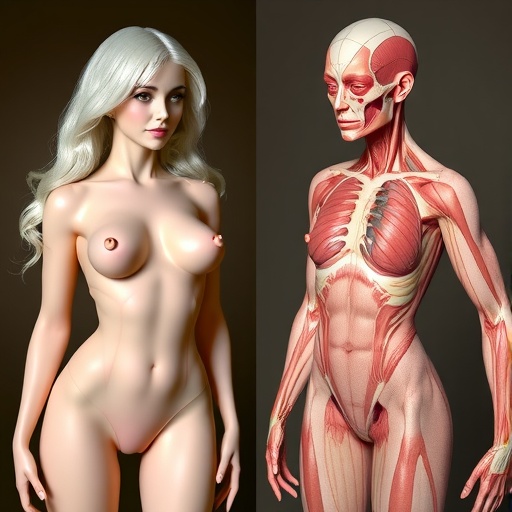In a groundbreaking study that has piqued the interest of researchers and the general public alike, the exploration of sex dolls compared to human body characteristics has emerged as a focal point of discussion. The research, led by scholars K.R. Hanson, N. Döring, and R. Walter, delves into the nuanced similarities and differences between the technical specifications of sex dolls and the variety and complexities of human anatomies. This inquiry not only sheds light on how these artificially designed companions reflect human traits but also raises critical questions about body image, intimacy, and societal norms surrounding sexuality.
The impetus for this study arises from the increasing prevalence of sex dolls in contemporary society, accompanied by a growing discourse around their impact on human relationships and sexual behavior. As technology advances, sex dolls have transformed dramatically—from rudimentary forms to sophisticated creations that mimic human features down to the tiniest detail. Researchers have taken notice of this evolution, which begs an examination of how closely these dolls can imitate the human body and the implications of that imitation.
Hanson and colleagues emphasize that the allure of sex dolls lies not only in their physical characteristics but also in the psychological attention they attract. The study aims to dissect the measurements, weight distributions, and material compositions of various dolls, placing these elements side-by-side with average human anatomical statistics. This juxtaposition aims to unravel themes about desirability and how dolls may influence personal desires and standards of beauty.
Physical parameters like height, waist circumference, and limb ratios are rigorously analyzed within the scope of the study. Dolls range widely in specifications, with some jackets designed to resonate with specific body types while others attempt to transcend typical human proportions. Such variations may invite contemplation regarding what constitutes attractiveness and how influenced preferences might be by media and cultural standards.
The authors meticulously evaluate surface textures and realistic features, which play an essential role in the tactile experience of interacting with a doll. Material choices, such as silicone and thermoplastic elastomer, are not merely about aesthetics; they reflect an understanding of human sensation and desire for authenticity. The research presents compelling arguments about how the sensory experience of a sex doll might either satisfy or bias an individual’s expectations of actual human interaction.
Highlighting the psychological dimensions further, the researchers argue that sex dolls may serve as a coping mechanism or a source of comfort for individuals or couples dealing with intimacy issues. This perspective aligns with contemporary discussions about the rising acceptance of human-technology relationships and encourages inquiry into the societal implications of such connections. By providing companionship, these dolls tread a fine line between fulfilling emotional gaps and creating potential reliance on non-human entities.
However, the study does not shy away from the ethical considerations that such a topic invokes. The ramifications of sexual doll ownership extend beyond personal experiences into broader cultural debates around objectification, fetishism, and the commodification of intimacy. Some critics assert that such trends could worsen societal Alienation, with individuals leaning towards synthetic companions rather than engaging in authentic human relationships. The researchers invite a diverse array of viewpoints, acknowledging this complex landscape without drawing reductive conclusions.
In approaching the data, the researchers employed a comprehensive methodology to procure accurate metrics. This not only entailed cataloging dimensions but also observing user interactions and collecting qualitative feedback on alterations in self-perception post-interaction. Such expansive approaches offer a multi-faceted view that underscores the distinct differences between physical presence and human essence.
With the study scheduled for publication in the esteemed journal “Archives of Sexual Behavior,” there exists a palpable anticipation regarding its reception amongst peers and the public alike. As sex dolls continue to proliferate in both popularity and sophistication, the research will undoubtedly contribute to ongoing conversations within the realms of psychology, sociology, and human sexuality.
As the discourse surrounding sexuality shifts and expands, the insights provided by this research could pave the way for better understanding human desires. The noticeable advancements in doll technology and design present an opportunity for reflection on our intrinsic needs for connection, love, and understanding.
In light of everything discussed, the research conducted by Hanson, Döring, and Walter lays an important groundwork for future studies. It melds the technical aspects of doll specifications with the deeper psychological implications, effectively bridging the gap between artificial intimacy and real human connection. The need for a balanced discussion around the benefits and downsides of such technologies becomes ever more critical, as societal norms evolve.
As we move forward, reflecting on these findings promises to open up more avenues of inquiry into not just sex dolls, but the broader implications of how society constructs intimacy and connection in an increasingly mechanized world. The urgency for interdisciplinary discourse that encompasses technology, psychology, and ethics has never been more apparent.
In conclusion, the intersection of human interaction with artificial companions invites a complex reflection that transcends mere metrics. In understanding the intricacies of this topic, we begin to unwrap the human experience itself, in all its raw vulnerability and intricate dimension.
Subject of Research: Sex Doll Specifications versus Human Body Characteristics
Article Title: Correction: Sex Doll Specifications versus Human Body Characteristics
Article References:
Hanson, K.R., Döring, N. & Walter, R. Correction: Sex Doll Specifications versus Human Body Characteristics.
Arch Sex Behav (2025). https://doi.org/10.1007/s10508-025-03369-y
Image Credits: AI Generated
DOI: 10.1007/s10508-025-03369-y
Keywords: Sex Dolls, Human Body Characteristics, Intimacy, Human-Technology Relationships, Body Image, Sexual Behavior, Psychological Implications, Ethical Considerations




